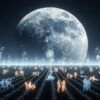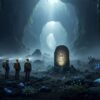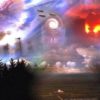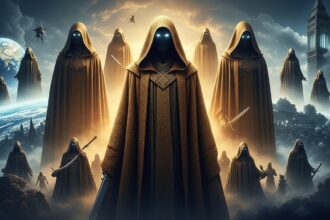Every triumph and tragedy in human history, the blood-soaked battlefields of ancient wars, the soaring symphonies of Beethoven, the quiet ache of unrequited love, even the raw edge of personal suffering, reduced to nothing more than a cosmic grocery list. Not the epic saga of our spiritual climb, but a mere tally of sustenance for that pale, indifferent orb glowing in the night sky. The Moon, in this view, is a voracious entity, and we’re its unwitting farm. This is the provocative heart of the teachings from George Ivanovich Gurdjieff, a 20th-century mystic whose ideas still rattle cages in philosophy, spirituality, and even science today.
Gurdjieff’s “lunar cosmology” flips our self-aggrandizing worldview on its head. It suggests a humiliating cosmic pecking order where humanity isn’t the pinnacle of creation but a cog in a vast, impersonal machine. And the wild part? Decades after his death, elements of his esoteric visions are finding unexpected echoes in modern astrophysics, biology, and planetary science.
Who Was George Gurdjieff? The Enigmatic Mystic Behind the Moon Theory
To grasp the weight of Gurdjieff’s ideas, you have to start with the man himself—a figure as elusive as a shadow in the moonlight. Born around 1866-1877 in Alexandropol (now Gyumri, Armenia) under the Russian Empire, Gurdjieff grew up in a melting pot of cultures. His father was Greek, a bardic poet who recited ancient epics, and his mother was Armenian (or possibly Greek, depending on the source). Fluent in Armenian, Pontic Greek, Russian, and Turkish, young Gurdjieff was steeped in diverse traditions from the get-go. Local priests and storytellers sparked his early fascination with hidden truths beyond science or conventional religion.
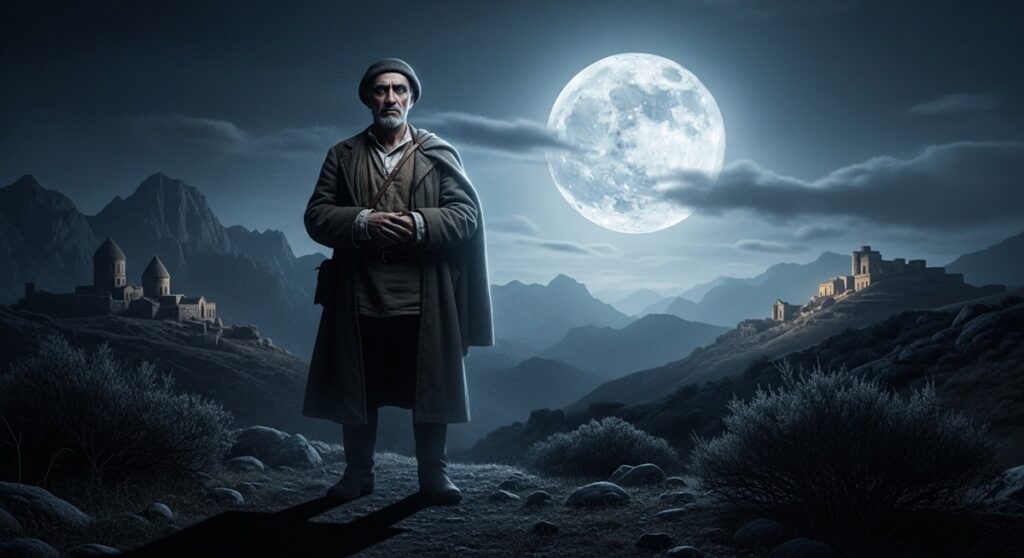
By his twenties, Gurdjieff embarked on epic journeys across Central Asia, Egypt, Iran, India, and Tibet, seeking esoteric knowledge from Sufis, yogis, and secret societies. He claimed to have uncovered fragments of an ancient wisdom system, piecing them together into what he’d later call the “Fourth Way.” Settling in Russia around 1912, he gathered students like the philosopher P.D. Ouspensky, who helped spread his teachings. After the Bolshevik Revolution, Gurdjieff fled to Europe, establishing the Institute for the Harmonious Development of Man in France in 1922. There, he taught through lectures, music, sacred dances, and grueling physical labor, anything to jolt people from their “waking sleep.”
Gurdjieff wasn’t your typical guru. He composed music with Thomas de Hartmann, wrote cryptic books like Beelzebub’s Tales to His Grandson, and even dabbled in business ventures. His methods were tough love: “Stop” exercises to freeze mid-action for self-observation, or tasks designed to expose ego. He died in 1949, but his legacy lives on through foundations worldwide. Critics called him a charlatan; devotees, a genius. Either way, his cosmology—especially the Moon bit—remains one of his most shocking contributions.
What drove him? A deep conviction that humanity is mechanically asleep, programmed like biorobots, squandering our potential. His lunar theory isn’t just cosmic trivia; it’s a wake-up call wrapped in metaphor, or is it?
The Core of Gurdjieff’s Lunar Cosmology: Humanity as Cosmic Livestock
At the heart of Gurdjieff’s worldview is a stark, unflinching declaration: “The Moon is the great enemy of man. We serve the Moon. We are like sheep that she raises, feeds, shears, and saves for her own personal use. But when she is hungry, she kills as much as she wants. All organic life works for the Moon.” Chilling, right? This isn’t poetry; it’s the linchpin of his cosmic hierarchy.
In Gurdjieff’s system, outlined in Beelzebub’s Tales and elaborated by Ouspensky in In Search of the Miraculous, the universe unfolds through a “Ray of Creation”, a descending scale from the Absolute (pure unity) down through galaxies, stars, planets, and finally, the Moon. The Earth and Moon are locked in a brutal symbiosis. The Moon, born from a catastrophic cosmic mishap, is a “sub-planet,” an immature entity struggling to grow. To sustain itself, it relies on Earth to generate a massive biological battery: organic life.
Us? We’re part of that battery. Humans, animals, plants, we absorb solar and terrestrial energies, then transmute them via our joys, pains, and deaths into “vibrations” or subtle ethers. These are cosmic nourishment that the Moon devours. Our wars? Emotional flare-ups that crank the energy output. Art and love? Byproducts of the churn. Creativity? Just steam from the engine. It’s a global conveyor belt where suffering amps up the “food” production, think mass tragedies as bumper harvests.
The Ray of Creation: A Cosmic Food Chain
Dig deeper into the Ray. Gurdjieff borrowed from ancient sources, blending them with pseudo-scientific flair. The Absolute emanates worlds in octaves, like musical scales, governed by laws: three at the top (unity), ballooning to 96 at the Moon (chaos). Organic life bridges a gap in this chain, transforming coarse matter into finer substances. The Moon, as the Ray’s endpoint, is a “growing branch,” a fetal world feeding off Earth’s output. Remove life, and the whole system stalls.

Ouspensky likened the Moon to a clock’s weight: “Organic life is clockwork… If the kettlebell is removed, the movement will stop immediately.” It’s elegant, almost logical, if you squint past the mysticism. But Gurdjieff insisted this isn’t allegory. The Moon is alive, evolving, and we’re its sustenance. Troubling? Absolutely. Yet it forces a rethink: Are we masters of fate, or glorified space cattle?
Prophecy in Myth: Gurdjieff’s Eerie Foresight on the Moon’s Birth
Here’s where it gets downright spooky. In Beelzebub’s Tales, Gurdjieff spins a yarn about the young Earth’s collision with a comet called Kondur (or Komdoor). The impact shears off two chunks: the big one becomes the Moon, the small one, a forgotten satellite called Anulios. In the early 1900s, this was dismissed as wild myth. Scientists favored gentler ideas, like the Moon budding from Earth or getting captured by gravity.
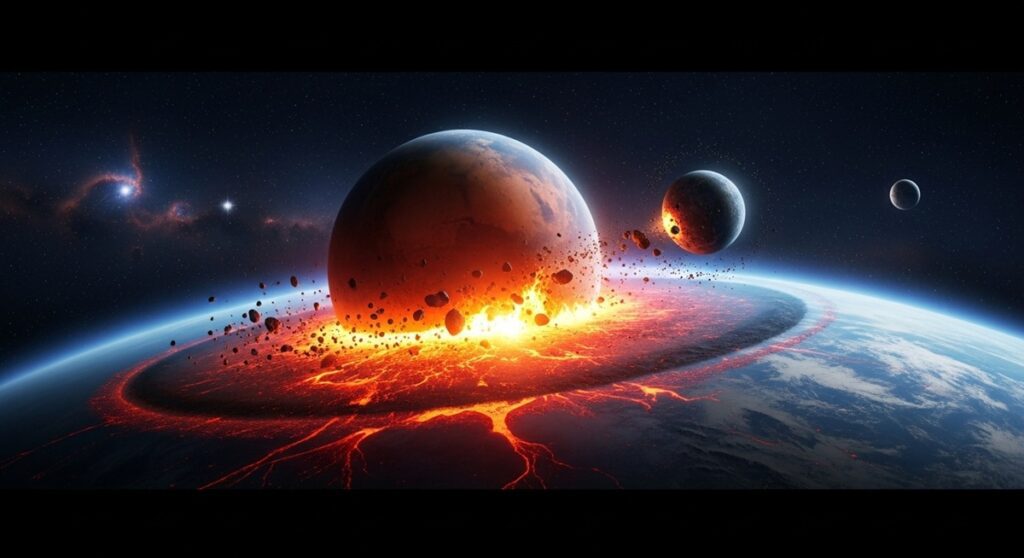
Fast-forward to the late 20th century, and bam—the scientific consensus shifts to the Giant Impact Hypothesis. Around 4.5 billion years ago, a Mars-sized protoplanet dubbed Theia slammed into proto-Earth. Debris coalesced into the Moon. Gurdjieff nailed the catastrophic origin, even if he called it a comet instead of a planet. He was decades ahead.
Latest Twists in Moon Formation Science
Science hasn’t stood still. Recent updates refine this tale. Lawrence Livermore National Laboratory research pushes the impact back to about 4.25 billion years ago, 300 million years earlier than thought, rewriting lunar history. Simulations suggest a glancing blow vaporized rock at 10,000°C, explaining the Moon’s tiny iron core and volatile-poor composition. In 2023, models proposed Theia’s remnants lurk inside Earth as massive mantle blobs, detectable via seismic waves.
A 2022 study shows such impacts can fling a Moon-mass body into stable orbit instantly, solving isotopic puzzles, Earth and Moon share near-identical oxygen and titanium fingerprints. Even lunar rust mysteries tie in: 2025 research links it to Earth’s atmospheric “wind” carrying oxygen. And Apollo 17 rocks? They’re now connected to the Sea of Serenity’s birth, hinting at volcanic timelines.
Gurdjieff’s “prophecy” wasn’t perfect— no Anulios found yet—but it’s uncannily close. Was he tapping ancient lore, or something deeper?
Gravity’s Grip: The Moon’s Tangible Hold on Earthly Life
Gurdjieff’s chain isn’t just ethereal; it’s gravitational. Without the Moon, Earth’s axis wobbles wildly, erasing seasons. Tides, lunar-driven, may have birthed life in primordial soups. Cycles influence everything: human sleep, animal migrations, plant growth.
Lunar Rhythms in Biology and Behavior
Studies show lunar phases sync with fertility, menstruation, and birth rates—melatonin dips under full moons. Animals? Corals spawn en masse; wolves howl more. Even humans: 2024 research ties moon cycles to health, debunking “lunacy” myths while affirming subtle effects. The impact may have homogenized Earth’s carbon, enabling autotrophic life origins.
Is this the “subtle exchange” Gurdjieff meant? Science says gravity stabilizes our biosphere; he hinted at energies beyond. Without the Moon, life might not exist—or it’d be alien.
Beyond the Physical: Vibrations, Fields, and Speculative Parallels
Gurdjieff’s “vibrations” sound woo-woo, but consider: Modern physics talks quantum fields, entanglement. A 2025 paper reframes his Moon as “recursive emergence” in a word-inhabited cosmos, blending Logos theology with cosmology. Morphic resonance (Rupert Sheldrake) or Akashic fields echo his ideas—collective memory as cosmic food?
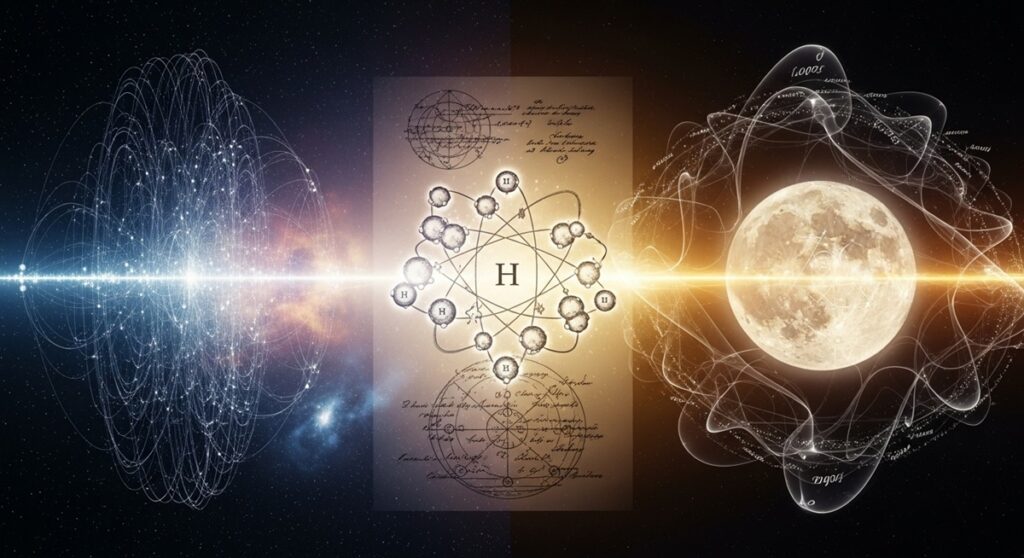
Critics slam it as anti-science: The Moon’s “cold, lifeless,” per astronomy. Yet parallels persist—his hydrogen atom hints predated subatomic discoveries.
The Fourth Way: Breaking Free from Lunar Bondage
Why this grim cosmology? It’s Gurdjieff’s alarm clock. We live in “waking sleep,” mechanical puppets. The Fourth Way offers escape: Work on all centers—body, emotions, mind—simultaneously, sans monastery.
Key Principles for Awakening
- Self-Observation: Watch yourself like a stranger.
- Conscious Labor: Do tasks fully present.
- Intentional Suffering: Endure ego hits.
- The Many ‘I’s’: Unify your fractured self.
- Laws of Three and Seven: Navigate life’s octaves.
Through movements, music, and effort, awaken to create your soul.
The Ultimate Wake-Up Call: Liberation in Understanding
Repulsive as “food for the Moon” is, it’s a ego-shatterer. Understand the chains, and freedom beckons. Gurdjieff’s revelation? Consolation in clarity. Who are we? What drives us? The Fourth Way says: Awake, and decide.


